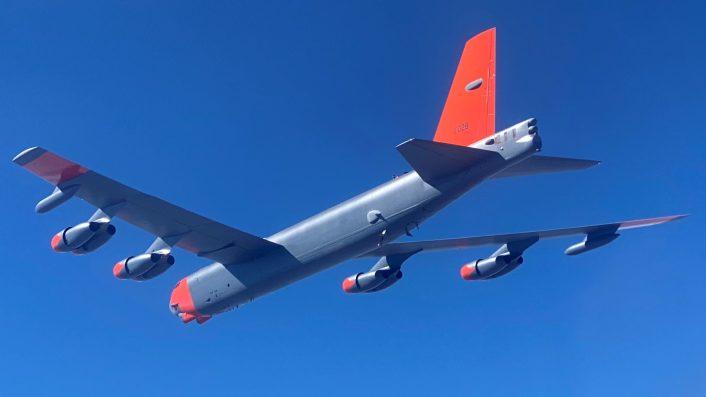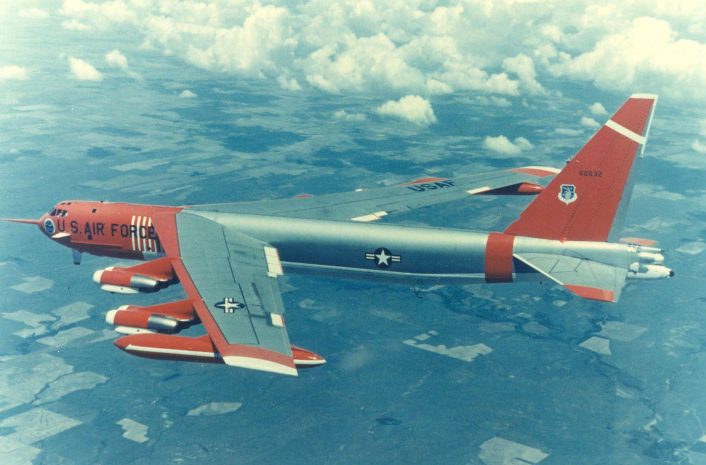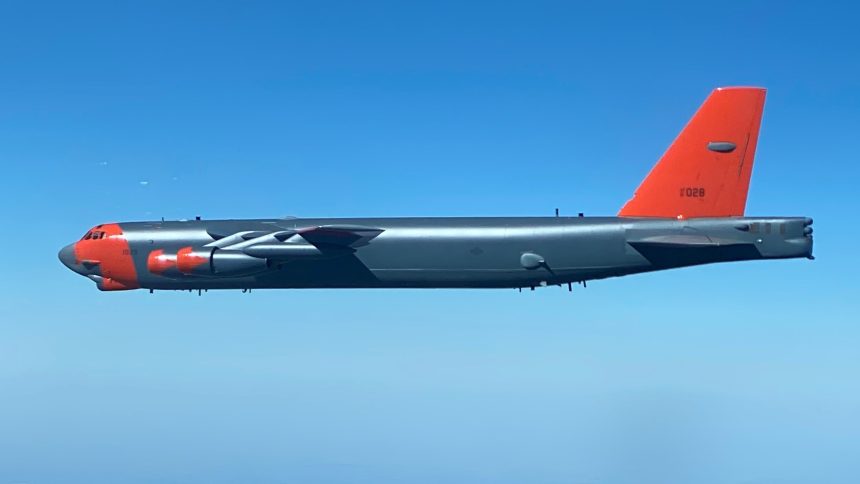The U.S. Air Force has released more photographs and details about the pretty unique the B-52H in orange paint scheme.
The U.S. Air Force has just released the first aerial photographs of the B-52H 61-0028 “Wolfpack” sporting a retro dayglo orange paint scheme. Along with the images, the U.S. Air Force has also posted an interesting article suggesting that the vibrant “test orange” paint scheme applied to a B-52H bomber, first seen departing from Tinker Air Force Base on Sept. 30, 2024, may draw its inspiration also from the lesser-known NB-52E. The eye-catching orange design pays homage to the aircraft’s legacy in experimental testing, but as the Air Force has revealed, it is tied to a distinct chapter in the B-52’s long history of innovation.

Initially, the striking orange accents were believed to evoke the famous NASA NB-52A and NB-52B aircraft (and, to be honest, the recent “throwback” paint scheme seems to match more closely the one of the NB-52A #52-0003), which played critical roles in supporting the X-15 hypersonic research program in the 1960s. These aircraft, adorned with orange markings, were instrumental in launching experimental vehicles and advancing early spaceflight technologies. However, the Air Force has now somewhat unveiled that the inspiration for the new scheme comes also from the NB-52E, a less celebrated but equally significant test platform that was pivotal in several research programs during the 1960s and early 1970s.
The NB-52E
The NB-52E, tail number 56-0632, was the second B-52E produced, heavily modified to carry out specialized developmental projects. Among its crucial contributions were studies on electronic flutter and buffeting suppression systems, key research areas since several B-52s had been lost due to structural failures caused by aerodynamic stresses during low-level flights. To combat these issues, the NB-52E was fitted with small swept winglets alongside the nose, and a long probe extended from the nose. The wings were also equipped with twice the number of control surfaces, and traditional mechanical and hydraulic linkages were replaced by cutting-edge electronic systems.

Inside the aircraft, a wealth of measuring instrumentation supported its research mission. The NB-52E was later involved in the Load Alleviation and Mode Stabilization (LAMS) project, which aimed to reduce the fatigue damage caused by wind gusts. Sensors installed on the aircraft detected and measured gusts, automatically activating the control surfaces to stabilize the aircraft and mitigate structural stresses. During mid-1973, the NB-52E achieved a significant milestone when it flew 10 knots faster than the speed at which flutter would have typically destroyed the aircraft.
Externally, the B-52E (and also the NB-52E) had a unique feature distinguishing it from the D models: an additional window on the left side of the bombardier/navigation station, which was absent in the D models.
Today, the NB-52E (#56-0632) resides in the “Boneyard” at the 309th Aerospace Maintenance and Regeneration Group in Arizona, having served its role in advancing aviation research. Its legacy, however, lives on through the newly painted B-52H, now assigned to 49th Test and Evaluation Squadron, where its orange livery serves as a reminder of the innovations that have shaped the B-52’s enduring presence in the U.S. Air Force.
Why Orange
“A heritage orange test and evaluation paint scheme represents a rich history of substantial advancements and progress within the U.S. Air Force, the test enterprise, and the B-52’s life cycle,” said Lt. Col. Sarah Silva, 49th TES commander in a press release that also provides some interesting historical details:
Orange has long been associated with testing and experimentation in aviation, with its roots tracing back to the 1940s. The paint scheme was intended to aid in recovery of downed aircraft and to decrease midair collisions. Some aviators wore orange jumpsuits to improve visibility in case they needed to eject.
The iconic Bell XS-1, which was painted orange to enhance visibility, set a precedent in 1947 when U.S. Air Force Capt. Charles “Chuck” Yeager became the first person to break the sound barrier in the aircraft known as “Glamorous Glennis.” This historic flight marked a turning point in aviation, paving the way for generations of test pilots and engineers.
The use of orange for test aircraft was further formalized in 1959, when a study recommended this bold color for marking test vehicles. By 1968, the Society of Flight Test Engineers had adopted “flight test orange” as part of its motto, solidifying the color’s significance to aerospace testing.
Silva emphasized the significance of the paint scheme: “By showcasing the test orange scheme, we are reminding everyone of the B-52’s incredible journey and the continuous progress made within the Air Force.”
The NB-52E, which played an instrumental role in pioneering the fly-by-wire control systems used in modern aviation, represents the innovative spirit that continues to drive the B-52’s modernization.
As the B-52 fleet undergoes upgrades aimed at extending its operational life into the 2050s, the aircraft’s legacy of testing and adaptation remains at the forefront. These modifications include new Rolls-Royce F130 engines, upgraded radars, and cockpit enhancements. In a way, the B-52H’s orange paint not only connects to the past but also symbolizes the aircraft’s future role as an advanced platform within the U.S. Air Force’s strategic arsenal.









